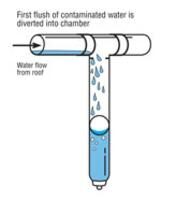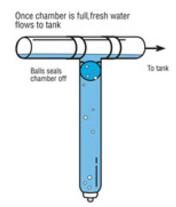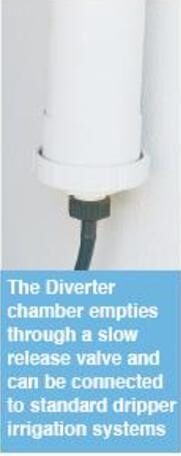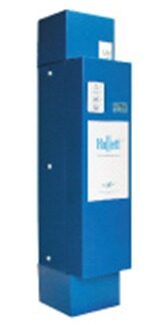Rainwater Filtration
RAINWATER FILTRATION
FIRST FLUSH DIVERTERS


Georgia Water Tanks stocks Rainharvesting Pty. downspout first-flush devices in 3″ and 4″, as well as the in-ground version.
First Flush Water Diverters improve water quality and reduce tank/cistern maintenance by preventing the first flush of water, which may contain roof contaminants, from entering the tank/cistern. They help ensure cleaner water is available for use, which protects rainwater pumps and internal household appliances such as clothes washing machines, toilets, hot water systems, etc. First flush diverters are generally not necessary for irrigation, but are required when treating water to drinking water standards.

Features and Benefits
- Prevents sediment, bird droppings, spiders, insects, mosquito eggs and debris from entering the rainwater tank/cistern.
- Improves water quality, protects pumps and internal appliances.
- Ideal to use in conjunction with a rain head.
- Easy installation, just add pipe and glue.
- Low maintenance requirements.
Resources
Purain USA
Product information, video demonstrations, etc., here
How do they work?

Fitting an appropriately sized First Flush Water Diverter is critical to achieve good quality water. Water Diverters improve water quality, reduce tank/cistern maintenance and protect pumps by preventing the first flush of water, which may contain contaminants from the roof, from entering the tank/cistern.
When it rains, water slowly builds up in the roof guttering system before it exits through the downspout. The first flush of water from the roof can contain amounts of bacteria from decomposed insects, skinks, bird and animal droppings and concentrated tannic acid. It may also contain sediments, water borne heavy metals and chemical residues, all of which are undesirable elements to have in a water storage system.
Instead of flowing to the water tank/cistern, these pollutants are diverted with the initial flow of water into the chamber of the water diverter. The water diverters from Rain Harvesting utilise a dependable ball and seat system – a simple automatic system that does not rely on mechanical parts or manual intervention.
As the water level rises in the diverter chamber the ball floats, and once the chamber is full, the ball rests on a seat inside the diverter chamber preventing any further water entering the diverter. The subsequent flow of water is then automatically directed along the pipe system to the tank/cistern.
For a water diverter to work effectively, the contaminated water in the chamber must be sealed off. This prevents the water passing to the storage tank/cistern and ensure the water does not “syphon” off the contaminated water in the chamber. The simplest and surest way to do this is with a floating ball and seat.
A slow release valve ensures the chamber empties itself after rain and resets automatically. The diverted water need not be wasted water because the drain pipe from the diverter chamber can be fitted to a standard drip irrigation system.
How much first flush water to divert
It is important to prevent heavy sediments and other roof pollutants from entering the rainwater tank/cistern. Also, dissolved organics can be more efficiently flushed away than filtered. The amount of water diverted should be a minimum of 12.5 gallons per 1000 square feet of roof area (or 0.0125 gallons per square foot). In calculating the amount of water to divert, consideration can be given to (1) the surface area of the roof, and (2) the amount of pollutants on the roof and gutters.
The following factors can be used as a guide in determining the volume of water to be diverted.
First Flush Sizing Chart
Example: 30 x 20′ garage with tree branches overhead:
600 s.f. x 0.05 = 30 gallons first flush. The downspouts and tank feed total 24′ of 4″ pipe, so
24*12*0.055 = 15.84 gallons. We need 30 – 15.84 = 14.16 gallons in the first flush device.
14.16/.49 = 28″of 12″ pipe in an underground first flush device.
As a rule of thumb, the more water that is diverted the better the quality of water in the tank/cistern.
Downspout First Flush Diverters, such as the 3″ and 4″ kits, are installed at each downspout that supplies water to the tank/cistern. They utilize a dependable ball and seat system – a simple automatic system that does not rely on mechanical parts or manual intervention. As the water level rises in the diverter chamber, the ball floats, and once the chamber is full, the ball rests on a seat inside the diverter chamber preventing any further water entering the diverter. The subsequent flow of water is then automatically directed along the pipe system to the tank/cistern.

UV Pure UV Sterilizers
UV Pure has always been my preferred UV manufacturer, and UV has always been my first recommendation for sterilization. Carbon is good, and also removes odors. But how do you know when it’s working or not? Who’s going to change the filter? In some cases, you will find a building operator who is diligent. UV Pure filters include local and optional remote alarm capabilities. So you know.